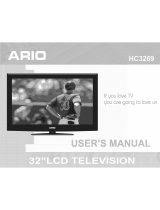
6
Studies indicate that plastics may weaken and crack
over time from the combined effects of chemical
agents and mechanical stress (such as the weight of
the TV). Failure to follow these instructions could
result inserious injury and!or permanent damage to
"FVand 'rv pedestal.
• Alwaysunplugthe-I'Vbeforecleaning. Gentlywipe
the display panel surface (the 'rv screen) using a
dry, soft cloth (cotton, flannel, etc.). A hard cloth may
damage the surface ofthe panel. Avoid contact with
alcohol, thinner, benzene, acidic or alkaline solvent
cleaners, abrasive cleaners, or chemical cloths,
which may damage the surface. Never spray volatile
compounds such as insecticide on the cabinet.
Such products may damage or discolor the cabinet.
37) Never hit, press, or place anything on the back cover.
These actions will damage internal parts.
38) ....... WARNING: ....
........... RISKOFELECTRICSHOCK! ,
Never spill liquids or push objects of any kind into
the 'rv cabinet slots.
39) During a lightning storm, do not touch the connecting
cables or product.
40) For added protection of yourrv from lightning and
power surges, always unplug the power cord and
disconnect the antenna from the "IV ifyou leave the -IV
unattended or unused for long periods of time.
41) Always unplug the "FVto completely disconnect from
mains power. When the "IV is turned off using the on/
off switch, itis not completely disconnected from power
and a minute amount of current is still consumed.
42) During norma! use, the TV may make occasional
snapping or popping sounds. This is normal, especially
when the unit is being turned on or off. Ifthese sounds
become frequent or continuous, unplug the power cord
and contact aToshiba Authorized Service Provider.
43)
PERSONAL INJURY OR EQUIPMENTWARNING: RISK OF SERIOUS
' _ ' DAMAGE!
Never strike the screen with a sharp or heavy
object.
44)
• The LCD screen of this product can be damaged by
ultraviolet radiation from the sun. When selecting a
location for the television, avoid locations where the
screen may be exposed to direct sunlight, such as in
front of a window.
• Nevertouch, press, orplaceanythingontheLCD
screen. These actions will damage the LCD screen.
Ifyou need to clean the LCD screen, follow the
instructions in item 36) on page 5.
Service
45)
WARNING: i ...........
RISKOFELECTRICSHOCK!
Never attempt to service the TV yourself. Opening
and removing the covers may expose you to
dangerous voltage or other hazards. Failure to
follow this WARNING may result in death or
serious injury. Refer all servicing not specified in
this manual to aToshiba Authorized Service
Provider.
46) Ifyou have the TV serviced:
• Ask the service technician to use only replacement
parts specified by the manufacturer.
• Upon completion of service, ask the service
technician toperform routine safety checks to
determine that the TV is in safe operating condition.
Choosinga locationforyourLEDTV
ToDisplay your LEDTV onthe included Pedestal Stand:
Observe the following safety precautions:
1) Read and follow the pedestal assembly instructions
included with the pedestal.
CAUTION: Before beginning pedestal assembly,
carefully lay the front of the LCD Panel face down
on a flat, cushioned surface such as a quilt or
blanket. Leave the bottom of the unit protruding
over the edge of the surface and assemble the
pedestal as described in this instruction document.
Note: Extreme care should always be used when
attaching the pedestal stand to avoid damage to
the LCD panel.
2) Place the TV on a sturdy, level surface that can
support the weight of the TV.
3) Be sure to secure the TV to a wall, pillar, surface, or
other immovable structure see item 26) on page 5 for
additional details.
To Display your LED TV using a Wall Bracket:
If you decide to wall mount your LED TV, always use a
wall bracket Listed by an independent laboratory (such
as UL, CSA, ETL) that is appropriate for the size
and weight of the TV:
1) CAUTION: Two people are required for installation.
2) Unplug and remove any cables and!or other
component connectors from the rear of the TV.
3) Remove the screws of the VESA Mounting Pattern
shown inthe table below, ifapplicable.
CAUTION: Do not use the screws removed from
the back cover to attach the wall mount bracket to
the TV.
4) Always use the screws supplied or recommended by
the wall mount manufacturer.
5) Follow the instructions provided with your wall bracket.
Before proceeding, make sure the appropriate
bracket(s) are attached to the wall and the back of the
TV as described in the instructions provided with the
wall bracket.
6) After attaching the appropriate bracket(s) to the wall
and the back of the TV, remove the pedestal stand
from the "IV, as described in this instruction document.






















